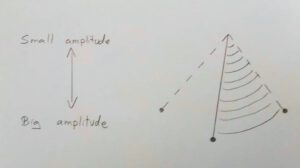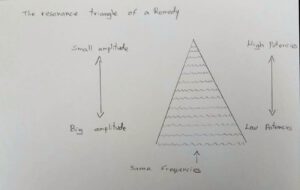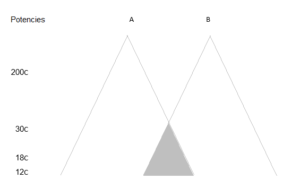Homeopathy works!!! No need to convince, you simply see it day by day at your clinic, it is clear and certain. Still I do believe it is important to challenge homeopathy in front of scientific theories and to try to model homeopathy into a well built and coherent scientific theories. It is not just that Homeopathy will earn a better position in the therapeutic world but it is also a chance for homeopathy to grow and earn some new insight sparkling from this friction between the wild nature of homeopathy and the structural nature of science.
So I would like you to see the following article: as an effort to model homeopathic clinical experience to meet the demands of scientific structure and coherence.
Offer for a physical model
As there are no scientific tools which are capable of explaining the way homeopathy works, describe it or measure it, put it under the microscope or quantify it, then, whenever we are trying to explain the way homeopathy works we are inclined to use terms as energetic fields, waves, frequencies…
I will start from that point, from the assumption that homeopathy rests on waves and frequencies as its platform to work and hill.
Say I take a short rope (might be 30 cm long) and bind a small ball to its end. I hold the rope on its end without the ball and start swinging it as a pendulum, than the ball start moving in a certain rhythm. There is a peak that the ball is coming for in both sides, right and left, and when it reached the peak than an opposite momentum is created to the other side. Now try to imagine this stretched rope from my fingers down to the ball when it reaches the left peak and then try again to imagine this stretched rope from my fingers to the ball when it reaches the right peak, we can think of it as the two sides of a triangle, left side and right side whilst my fingers holds the vertex of the triangle.
We can think of this pendulum motion also as a waves, frequency of waves is determined by the number of times it reaches the peaks, say the number of times per minute our pendulum reaches its right peak and left peak (frequencies are actually measured by time units of seconds and not minutes, and in Hrz scale. I chose minutes just because it seems hard to imagine our pendulum motion measured by seconds). Another aspect of this motion is its amplitude, the amplitude designate the distance between point of zero motion (actually where the ball lies before motion is generated) till each peak points, right or left.

I imagine this rope now swinging right and left. Please be aware that the frequency along the rope (from the end held by my fingers down to the end tied to the ball) remain the same. Means that when the ball reaches the peak, also any other imaginary point above it along the rope is reaching its end. So that the frequencies of any imaginary point along the rope is just the same. What differs between the imaginary points along the rope is the distance each of them have to travel between point of zero to its peak. whilst the ball in the bottom have to travel the longest distance to reach its peak every point above it needs to travel a shorter distance to its peak, till the end point just beneath my fingers which hardly makes any motion.
So if we use physics terminology we would say that along the rope frequencies remain the same but the amplitudes are changing, bigger amplitudes in the bottom and smaller amplitudes at the top.
Now let's imagine the triangle shaped by this pendulum motion. As said before, frequencies anywhere in that triangle remain the same (the frequencies along the rope which shapes this triangle stay the same), the only thing that change is the amplitudes, bigger the amplitude close to the basis smaller the amplitude close to the vertex.

O.K. and all that is what about?
I would like to think on such a triangle, triangle which is specified by its unique frequencies and by its unique amplitude, a triangle which is specified by its unique wave form (waves off course can be graphically represented by their frequencies and amplitudes) as a picture of a remedy, as the physics representation of a remedy, I would call it the resonance triangle of the remedy. And to be more accurate, I would like to think of its frequencies as designating of which remedy and its amplitude as designating of which potency[1].
As said, the base of the triangle is where the bigger amplitudes are, the bigger the amplitude the stronger and powerful the waves are. The big amplitudes, those strong wave's motion are equivalent to the low potencies (explanation to follow). So at the bottom of the triangle is where the low potencies are and the higher we move toward the vertex the higher the potencies are. We may imagines layers and layers of potencies levels lying one on top the other like a building stone of a pyramid.
How waves characterize remedies and potencies:
Waves frequencies = Remedy
Waves amplitude = Potency
Bigger amplitude = Lower potency
Smaller amplitude = Higher potency
Lower potencies are stronger potencies (as said, represented by the bigger amplitudes in the base of the triangle) In the sense of being capable to generate much more "noise" and reactions in their surroundings, the volume of motion and the resonance they create can much more easily create a change. They might be noisy and rough, they might not be the most accurate and delicate but still their value laid in their ability to generate a change more easily than the higher potencies. Just as a wave with a bigger amplitude is capable to generate a motion more easily than a wave with a smaller amplitude (in voice waves for instance, the volume of the sound is set by the amplitude of the wave, the bigger the amplitude the stronger the volume, while the tone is set by the frequencies) so does lower potencies are wilder and stronger and can generate a reaction more easily than the higher potencies.
The work with the lower potencies is in a way "rougher" compare to the chirurgical accuracy required when working with higher potencies. With lower potencies you may generate a hilling reaction even if you just resonance nearby, still when working with higher potencies this "nearby" would not be enough. Lower potencies, their strength, their muscular amplitude, can generate a change in their surroundings much more easily than the higher potencies with their small, strictly-measured amplitude. Clinically speaking, when you treat a case on which lower potency is required (for instance a patient with mostly a stubborn physical pathology) than the accuracy required on choosing the remedy is lesser than the accuracy required when you treat a case upon high potency is required (for instance when treating a patient experiencing his pathology in a clear spiritual manner). In other words, when you stand in front of a case on which low potencies can do the "work" than there is a certain likelihood that also neighboring remedies (when I use the term neighboring remedies here I mean clinically neighboring, which means neighboring in terms of fitting to treat a certain pathology, and this meaning of neighboring is different than the meaning we regularly attach to neighboring remedies, as remedies which have a similar character) will be able to generate a hilling reaction, But if you are to treat a case upon high potencies are required so than the chance that any of those neighboring remedies might generate a hilling reaction is reduced.
Remedies in low potencies are like trying to open a door by force. Knocking, pushing, rocking, shaking… Remedies in high potencies are like facing the door with a key. Still, keeping this analogy… a key can open its one door only while pushing and rocking can open variety of doors (in a way pushing and rocking can open almost every door, this off course does not means that low potencies will suit every patient. Analogies are to be stopped on a certain point!)
The image of this triangle, with the lower potencies in its wide bottom and the higher potencies as you move towards its closing vertex is also a good representation to the wider possibilities for remedies to act closer to the bottom and the less possibilities and more accuracy required as you climb towards the vertex. It is like that the wide bottom is capable of accommodating more possibilities for remedies while the narrowing it become as you climb toward the vertex leaves no space for error.
Those low chubby potencies are wonderful to work with, it is much more easy (require less precision) to try moving pathologies with them. We need to work with them thoroughly and to utilize their abilities to hill the patient. As said the higher we go with potencies the more precision in choosing the remedy is required, this can also explain those cases when a remedy stop its action when we move to an higher potency. This is because the higher potencies can no longer afford the looseness available in the lower potencies, this is because the higher potencies require sharpness, requires work with a higher resolution. Many times I so how remedy which create a hilling reaction in potency 12C for instance loose its ability to effect the patient once we step higher with the potency, even a small step higher, say for 15C. This is because the looseness available in a lower potency (in this case 12C) is no longer available in higher potency (in this case 15C), this is because lower potencies allows more room for "nearby remedies" than higher potencies which requires more precision. It is like that the higher we go in the triangle with potencies, the higher we climb towards the vertex and the narrower the space around, there is less space for "nearby" and the more precision in work is required. At that point, when a remedy stop its reaction after we went higher with the potency it means that we need to think of another remedy or trying to go back to the previous lower potency to see if it can still create a hilling reaction.
The illustration bellow shows how the resonance triangle of remedy A and the resonance triangle of remedy B shares a common hilling field (the grey area), still, the higher you go with the potency the less the field they share and the more differ they become in the kind of symptoms and pathologies they can cure. We can see that in potency 12C there is quiet a big field of cure they share together, still in potency 18C they share less of a common field, in 30C they hardly share and in potency 200C they share none of a common field, so that in potency 200C a patient hilled by remedy A will not be able to hilled by remedy B and vice versa. The illustration shows how the lower we are with the potencies the wider their scope of influence and the more likelihood of overlapping between remedies. The illustration also shows how narrow and pointed is the scope of higher potencies and consequently how targeted, and precise must be the work with higher potencies.

This model can explain also the antidoting of remedies, this is by the interference of waves. Interference of waves will result in cancelling each other's effects when trough of one wave meets the crest of the other wave simultaneously. Accordingly antidoting between remedies will occur when the troughs of wave of one remedy is meeting the crests of wave of another remedy (When the waves are totally symmetrical than the interference will be absolute, and consequently a total antidoting. Still interference of waves is not necessarily symmetrical, interference between waves might be partial and consequently also antidoting is not necessarily absolute but might be partial as well).
Interference of waves:

*****
I have offered a model which is capable of explaining some of our clinical understanding by physics terms. Off course there is no possible way yet to prove it right or wrong. Still the beauty of that model (If I may expresses in that manner) lies in its ability to keep our clinical experience coherence within a physics model.
It might be that all which have been brought here holds nothing but the paper it is written on, it might be that days will shows that the model is wrong. But meanwhile, speaking for myself at least, the coherence of this model with our clinical experience makes a reason (sense) for me, and makes my clinical work more confidence, calm and systematic.
There is so much uncertainty in our work and even if all I have been offered here is non more than whistling in the dark, still it gives me comfort.
[1] I use this example of triangle which is shaped by the motion of the pendulum to illustrate a scope of work, a triangular scope of work in which the waves are resonating in a specific frequencies and a specific amplitude. As the pendulum moves in a cyclic way and an unchanged frequencies so are the waves in our illustration become cyclic harmonic waves (waves characterized by a smooth cyclic motion), having the same one frequency. Still it is reasonable to assume that waves of remedies will not necessarily be cyclic harmonic waves but rather a waves which their frequencies is changing and breaking. That the wave of remedy A for instance (we may say… remedy A physics identification tag), their frequency will not be cyclic harmonic but rather a changing and breaking frequency.
